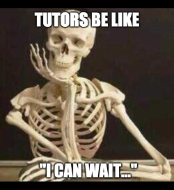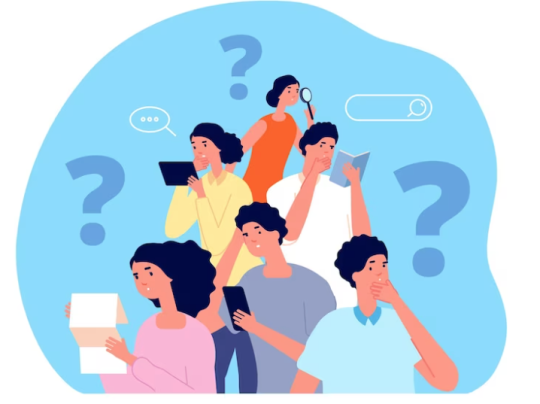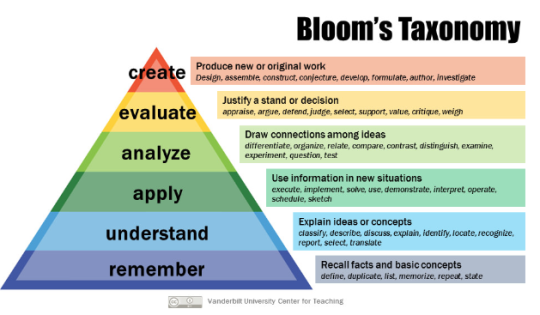The Three Primary Strategies
Wait Time
Definition: Wait-Time is the time that elapses between a tutor-initiated question and the next behavior (student response or the peer educator talking again). There are two kinds of wait-time:
- Wait-Time 1: The time the peer educator waits after asking a question.
- Wait-Time 2: The time the peer educator waits after a response is provided, regardless of accuracy. This pause allows students to elaborate on their answer and be more engaged.

Why Wait-Time is a Useful Facilitation Technique:
Periods of silence that follow peer educator questions and students' completed responses rarely last more than 1.5 seconds in typical classrooms. Research shows when students are given 3 or more seconds of undisturbed "wait-time" or “think time” there are certain positive outcomes:
- More students answer
- Answers are more accurate, elaborate, reasoned and supported
- Students listen to each other more
- More questions are asked
- Shy students are more likely to participate
So how long should you wait? This depends on the complexity of the question, the ability of the students, and the clarity with which the question was asked. In general, recall and lower-level questions will take most students 1-3 seconds to answer. Questions that require calculation usually take 4-6 seconds to generate a response. Higher-order questions that require more thought than the simple recall questions could take anywhere from 6 to 10 seconds to formulate a reply.
What to do when students don’t respond:
| Repeat the question | Make the question more specific |
| Rephrase the question | Ask the student to rephrase the question |
| Simplify the question | Break the question down into its component parts |
Reference: Rowe, M B 1972, “Wait-Time and Rewards as Instructional Variables: Their Influence on Language, Logic, and Fate Control”
Redirecting Questions
Definition: Redirecting questions is a technique of responding to a student’s question with another question. Redirecting questions is meant to help guide students to the answer by prompting them to use their available resources such as fellow students in the tutoring session/lab, their prior knowledge, their notes, or the textbook. See the sample interactions below to get a better sense of how redirecting questions might play out in sessions.

| (Single tutee in a session - two scenarios) Student: I don’t understand how temperature affects a chemical reaction. Tutor: I’m glad you brought that up! Let’s analyze #5 on your homework to see if we can understand how temperature affects different reactions. We’ll see if we can come up with the reasons by the end of the session. ................................................. Student: I don’t know how to do this problem. Tutor: What part(s) of the problem do you understand? [This will help narrow the question and divide it into more useful parts.] |

| (Multiple tutees in one session) Student: What is the derivative of a constant? Tutor: Can anyone find an answer to that in your notes/text? [Use the resources that students have. This models good student behavior and makes students process material in a way that will be helpful for them.] |

| (Multiple tutees in one session - three scenarios) Student: What is the derivative of a constant? SI Leader: Can anyone find an answer to that in your notes/text? [Use the resources that students have. This models good student behavior and makes students process material in a way that will be helpful for them.] ................................................. Student: I don’t understand how temperature affects a chemical reaction. SI Leader: I’m glad you brought that up! Let’s analyze #5 on the handout to see if we can understand how temperature affects different reactions. We’ll see if we can come up with the reasons by the end of the session. ................................................. Student: I don’t know how to do this problem. SI Leader: What part(s) of the problem do you understand? [This will help narrow the question and divide it into more useful parts.] Or...Would someone please go to the board and scribe as we work it together? |
Why Redirecting Questions is a Useful Facilitation Technique:
One of the most important moments of a tutoring or SI session happens when the student asks the peer educator a direct question. If the peer educator answers the question for the student, sessions will soon be reduced to the peer educator answering questions and re-lecturing over the material. It is therefore critical to the overall goal of sessions that questions be redirected to the student or the group to be answered. This is more difficult than it sounds because it’s counter intuitive not to answer a question to which you know the answer. In short, redirecting questions:
- Breaks the dependency cycle, students learn how to solve problems on their own
- Models good student behavior
- Can involve multiple students
What is this question asking for? Why are you thinking of it in that way? How is your answer (point of view) different from ____? Can you be more specific? Can you find the answer in their notes? | Give an example of that. Let’s look that up into the text. Let’s write down everything we know about this topic/problem/theory. Let’s rephrase it on the board and figure out what information we will need to answer it. |
The Inside Scoop on Redirecting Questions
When redirecting a student’s question, you’ll want to assess what kind of question is appropriate for their knowledge level of the content while still challenging them.
Questions that require students to think: It’s all in the verbs. “Can you….define, describe, solve, compare, defend, develop…?”

Checking for Understanding
Definition: Checking for understanding is the frequent, interactive checking of student progress and understanding. This technique allows peer educators to verify that students understand the content and have learned the material.
TIP: Avoid close-ended or vague questions such as: “Did you get all of that?” “Any questions?” “Does that make sense?” These questions can be answered with a simple yes or no. Students may also be uncomfortable admitting that they still do not understand a concept.
Why Checking for Understanding is a useful Facilitation Strategy:
- The peer educator can verify if students understand a concept, problem, the text, etc.
- If students still do not understand, the peer educator can adjust their session accordingly.
Other possible ways to check for understanding:
- Ask the student (in a tutoring session) or a volunteer (SI session) to write the main points of the discussion on the whiteboard or–if sessions are over Zoom–into a shared Google Doc (virtual) or on the whiteboard (virtual).
- Ask for real-life examples of applications of the concept.
- Ask for a similar problem, metaphor or analogy.
| Looks Like... | Sounds Like... |
| Eye Contact | Explain that to me please. |
| Leaning forward | Can you show me? |
| Interested expression | How do you get that answer? |
| Open gestures and posture | Give me an example please. |
Return to the main LARC Handbook Page.

